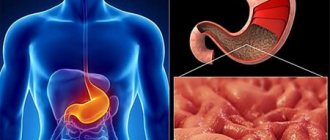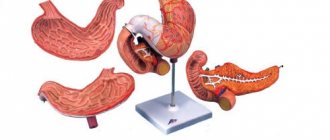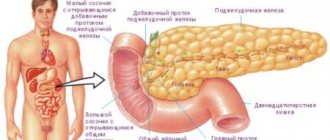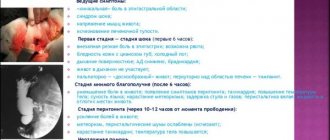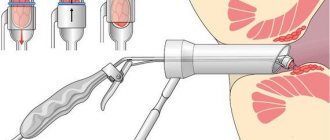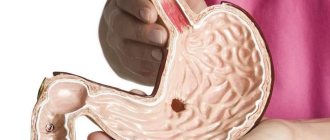The structure of the duodenum and erosion
The initial section of the small intestine, 12 fingers long (about 300 centimeters), starts from the stomach and flows into the jejunum. Diameter – 45-47 mm. Its upper part is thickened like an onion (ampule). Depending on the bends of the organ, the upper part, descending and horizontal, ascending, are distinguished.
The walls of the duodenum consist of several layers:
- the outer shell is a continuation of the outer shell of the stomach;
- a muscular middle layer, consisting of two types of bundles - longitudinal and circular, which allows the intestine to contract and reduce its diameter;
- the internal mucous layer that forms folds - longitudinal in the upper part, circular - in the remaining parts of the organ.
The lining of the intestine has formations called intestinal villi, at the base of which there are glands that produce intestinal juice and a number of digestive hormones. In the central part of the villi there are blood and lymphatic vessels that are involved in the process of transporting nutrients to the body.
In the downward part of the organ there is a formation in the form of a tubercle - the nipple of Vater. Bile and pancreatic juice, necessary for digestive processes, flow through it; the flow is regulated by the sphincter of Oddi.
The main role of the duodenum:
- transport - the contents of the stomach after additional processing move further into the intestine;
- motor - contractions of muscle fibers allow the contents of the intestines and digestive juices to mix;
- enzymatic - glands at the base of the villi produce food enzymes and hormones (enterokinase, gastrin, cholecystokinin).
Erosion of the duodenum - damage to the superficial internal mucous layer, which looks like wounds of various shapes and sizes, ranks second in the world among diseases of the digestive organs in terms of frequency of detection.
The lesions do not penetrate into the muscle layer, as with an ulcer, the healing process has a specific course and does not leave traces, which allows us to consider erosion of the duodenum 12 as an independent disease, and not the initial stage of a peptic ulcer.
Symptoms of pathology
Manifestations of the disease in the early stages go unnoticed; patients attribute it to ordinary eating disorders. Subsequently, complaints arise about:
- nausea and vomiting;
- decreased appetite;
- weight loss;
- abdominal pain after eating.
During the examination, the doctor determines pain in the upper abdomen. The appearance of discomfort after eating depends on the location in the intestines where the symptoms of erosion are located.
Most often, mucosal destruction occurs in the upper parts of the duodenal bulb. In such cases, pain will appear an hour after eating. Such a lesion is considered the most dangerous - the upper part of this organ is located near the nerve plexuses (vagus nerve) and causes a large number of neurological pathologies.
Erosion of the bulb over a long period of time develops into a peptic ulcer, the treatment of which is always long and difficult. The main symptoms that indicate this type of pathology are the following:
- loss of appetite;
- poor digestion;
- heartburn;
- belching;
- flatulence.
The order of these symptoms manifests itself individually and depends on the characteristics of the body. At certain stages, pain of a different nature may occur:
- dull;
- aching;
- spasmodic;
- burning;
- radiating into the chest.
The pain is most often felt at night and on an empty stomach, although it is never permanent. Discomfort after eating resembles bloating - even a small amount of food causes a feeling of fullness.
Additional symptoms of acute duodenal erosion include:
- intestinal and gastric bleeding, which is indicated by the dark color of the stool, caused by the effect of specific intestinal contents on fresh blood;
- nausea and vomiting of clotted blood;
- weakness and anemia;
- manifestations of general intoxication;
- intermittent stools;
- stool disorders.
With erosion of the stomach and duodenum, symptoms may occur that indicate the occurrence of neurological symptoms:
- discomfort and heaviness in the right hypochondrium;
- heaviness and pain in the upper abdomen;
- pain in the heart area;
- pressure behind the sternum.
When diagnosing, the doctor is faced with the task of separating duodenal erosion and symptoms of possible heart or liver diseases.
Forecast
With late diagnosis, defects in the intestinal mucosa lead to recurrent bleeding and anemia. The disease progresses, complications develop: erosions turn into ulcers, cicatricial deformation of the intestinal wall occurs. With proper treatment, intestinal erosions heal completely within 3-4 weeks.
Any pathological processes that directly develop in the gastrointestinal tract or affect them can significantly affect the general condition of a person.
Among such diseases one can name erosive formations in the direct intestine. If left untreated, they can cause the development of extremely dangerous diseases for the patient. So, what are the nuances in treating the symptoms of rectal erosion, and what exactly do doctors recommend in this case?
Causes
The main factors for the occurrence of duodenal erosion are the same as for gastric erosion and peptic ulcer. This:
- infection with the bacterium Helicobacter pylori;
- constant stressful environmental pressure;
- low level of immune defense;
- recent viral diseases, surgical interventions;
- violation of the eating regime, consumption of too spicy, hot and rough foods;
- smoking and alcohol;
- use of certain medications - non-steroidal anti-inflammatory drugs, antibiotics, aspirin, some hormonal drugs;
- cirrhosis of the liver (it is believed that acute erosion most often accompanies cirrhosis caused by viral hepatitis, chronic erosion - with alcoholic liver damage);
- neoplasms in the gastrointestinal tract;
- diseases of the digestive system (disturbances in the functioning of the gallbladder, which reduces the disinfection function of bile).
The exact mechanism of the occurrence of erosions is unknown; an approximate diagram of the formation of pathology looks like this:
- the level of protection of the mucous membrane of the duodenum and stomach decreases due to a decrease in the production of protective mucus;
- the rate of regeneration of the mucosal epithelium decreases;
- blood circulation in the walls of the stomach and intestines is disrupted;
- under the influence of the two previous factors, the intestinal mucosa cannot quickly restore the areas on the mucous membranes affected by aggressive digestive enzymes.
Erosion can be acute and last no more than a week, then drag on without a trace, and chronic, which is open for a month or more.
What is rectal erosion
The presence of erosive foci in the rectal area indicates the formation of an inflammatory process in the mucous tissues of the rectum. A distinctive feature of such erosions is their ability to heal without further scar formation.
The disease occurs in patients of both sexes in the middle age group.
Rectal erosion is a disease that belongs to polyetiological pathologies and develops as a result of infectious or non-infectious complications. In addition, the disease can occur in both acute and chronic forms.
The acute form is characterized by a ten-day manifestation, and in the advanced stage – a month and a half, but the chronic form of the disease can last 5 years or more.
The nature of erosive lesions of the mucous membranes usually consists of multiple or single groups, and the erosions themselves have various forms: flat, hemorrhagic, polypous.
In the absence of timely therapeutic measures, chronic erosion of the rectum in the photo above can acquire an erosive-ulcerative nature, which in the future is dangerous for the development of serious infections and the appearance of pus, which can spread to neighboring tissues, which significantly increases the risk of developing paroproctitis.
Diagnostics
When a patient complains of abdominal pain and indigestion, nausea, the doctor determines the disease by:
- taking anamnesis;
- external examination of the patient, palpation of the abdominal wall;
- prescribing a general and biochemical blood test;
- laboratory testing of urine and feces (for occult blood);
- blood tests for HIV and viral hepatitis;
- prescribing an X-ray examination with a contrast agent;
- carrying out endoscopic examination.
The most accurate diagnosis can be established by performing a diagnostic endoscopic examination (fibrogastroduodenoscopy). Visual examination of the mucosal surface under magnification allows you to see and carefully examine all affected areas. If necessary, during such an examination, you can take particles of mucous membranes to determine:
- acidity;
- epithelial conditions;
- presence of Helicobacter pylori and other infectious agents.
The doctor needs to exclude the presence of intestinal bleeding from the erosion zone - this greatly weakens the patient and should be stopped first.
Based on the results of the examination, the type of erosion is determined:
- hemorrhagic acute;
- chronic;
- single or multiple;
- erosive-hemorrhagic duodenitis.
With erosion of the bulbs there are:
- focal erosion;
- drain (when several local foci are connected);
- hemorrhagic.
Areas affected by erosion on the surface of the duodenum can be combined with ulcerative lesions of the mucous membranes, which affects the muscular layer of the organ.
Treatment
After determining the diagnosis, treatment for duodenal erosion is prescribed. The treatment strategy is determined by the attending physician depending on:
- presence of bleeding;
- Helicobacter pylori infection.
Main goal of treatment:
- restoration of the integrity and functionality of mucous membranes;
- raising the immune status of the body.
There are no differences in the treatment regimen for erosions in any area - lesions on the bulb are treated in the same way as on any part of the duodenum. All prescriptions and adjustments of therapy are carried out exclusively by a doctor.
Main directions in treatment:
- decreased acidity of gastric juice;
- stopping bleeding;
- destruction of Helicobacter pylori;
- symptomatic treatment;
- sedatives;
- restorative therapy;
- treatment with folk remedies;
- diet and lifestyle changes.
Regulating the acidity of gastric juice is carried out using:
- drugs with acidity-regulating action (ranitidine, cimetidine, Relzer);
- proton pump inhibitors (Omez, Omeprazole, Nolpaza).
To relieve pain use:
- antispasmodics Drotaverine and Spasmol;
- products with an enveloping effect Maalox, Almagel.
To eliminate infectious agents, use:
- Clarithromycin and Amoxicillin;
- Ampiox;
- Metronidazole.
When treating hemorrhagic forms of erosion, treatment is prescribed to replenish blood loss: blood transfusions or plasma administration. Preliminary medications are administered to stop blood loss. As a general strengthening therapy, immunostimulating therapy and vitamin preparations (groups B, C, E, PP) are prescribed.
Inpatient treatment can be replaced with outpatient treatment if the lesions are minor and do not cause bleeding. Alternative treatment is used only in the absence of bleeding and after consultation with the doctor.
Treatment of duodenal erosion with folk remedies
Herbalists and adherents of alternative medicine methods confidently claim that folk remedies, proven over the years, work effectively in the fight against erosive defects and have the ability to heal even the most old and chronic changes in the inner wall of the digestive tract.
Doctors strongly recommend:
Before starting any traditional medicine method, consult a specialist! and
The injured mucous membrane is very delicate and any careless intervention, ingestion of herbs or tinctures can cause bleeding or other complications of the disease.
It is necessary to try folk remedies only after the permission of a doctor and under his supervision.
Plants with anti-inflammatory properties are widely used in folk therapy methods: oak, St. John's wort, plantain, elecampane, yarrow.
Licorice, mint, chamomile, dill, and fennel effectively relieve pain and have an antispasmodic effect.
Calamus, marshmallow, sea buckthorn oil, and flax seed have an enveloping, wound-healing effect.
The following folk remedies are used to treat duodenal erosion:
- Calamus root powder (on the tip of a knife) is taken three times a day half an hour before meals for about a month
- Fresh potato juice should be drunk half a glass three times a day half an hour before meals for two months. The starch contained in the juice has an enveloping effect, enhances reparative processes, soothes and relieves inflammation, reduces pain
- Brew 3 tablespoons of flaxseed in 500 ml of boiling water, leave for about a day. Drink half a glass before meals before each meal. This infusion also has a laxative effect, so this recipe is not recommended for people with loose stools.
- 15 g of chopped dry licorice root, 8 g of dried orange peels, pour 300 ml of water, cook over low heat until half the volume of liquid boils away, strain. Add 50g honey. The received dose should be divided into two parts: the first part should be drunk in the morning before meals, and the second in the evening - 2 hours before going to bed. Treatment course 35 days
- Grate 40 g of propolis on a fine grater, after keeping it in the freezer for 20 minutes, pour in 500 g of olive oil, boil for 3 minutes in a water bath. Drink 1 dessert spoon warm once a day in the morning on an empty stomach.
- A decoction of calamus rhizome is taken orally, 1 tbsp. three times a day before meals
Traditional medicine recipes
Folk remedies are used in consultation with a doctor.
- sea buckthorn oil in capsules three times a day before meals (not recommended for diseases of the liver or biliary tract);
- herbal mixture of yarrow, chamomile, mint, St. John's wort flowers and sage leaves in equal parts. Brew a teaspoon per glass of hot water and drink 150 grams before meals;
- a mixture of carrot juice and raw chicken yolks, half a glass 2 times a day before meals;
- chamomile infusion at the rate of 1 teaspoon (or sachet) of the product per cup of very hot water.
For treatment, a decoction of nettles (a tablespoon per glass of water) and a decoction of oat grains (in the same ratio) are also used. The decoctions are filtered, mixed and drunk ½ cup 30 minutes before each meal.
Nutrition for erosion
Properly organized nutrition helps to get rid of the disease even without the use of drugs. The main requirement for nutrition is its regularity. Meals should be small and frequent. It is recommended to consume no more than 300 ml of food at a time. Long breaks in eating are prohibited.
In case of a pronounced erosive process, it is recommended to introduce an increased amount of protein into the menu. It is necessary for the complete restoration of the damaged mucosa.
Allowed dishes for erosion:
- porridge (from rice, semolina);
- jelly;
- compotes;
- vegetables (except radish and cabbage);
- boiled lean meat (preferably chicken, veal and beef);
- boiled or steamed fish;
- oils (the most useful are butter and olive);
- fresh juices;
- boiled eggs (no more than 1 per day);
- mashed potatoes;
- puddings;
- cutlets cooked in a steam bath.
It is necessary to exclude from the diet:
- alcohol;
- cabbage;
- coffee;
- chocolate;
- dishes with dyes and flavors, preservatives;
- pickles;
- marinades;
- smoked meats
Causes
Erosive bulbitis, like other diseases of the digestive tract, originates from the patient’s unhealthy lifestyle, a tendency to abuse bad habits and a love of unhealthy but delicious food.
The main reasons for the development of the disease:
- poor nutrition;
- smoking and drinking alcohol on an empty stomach;
- uncontrolled use of certain groups of drugs that contribute to the destruction of the duodenal mucosa;
- peritoneal trauma;
- prolonged exposure to stressful situations;
- infection with the microorganism Helicobacter pylori;
- heredity.
Often there is a complex of factors predisposing to the disease, as well as a history of other diseases of the digestive system (gastritis, pancreatitis, dysfunction of intestinal motility and other problems).
Symptoms
Symptoms of erosion may not be noticed by a person for a long time. The clinical picture is blurred; the patient often attributes the primary signs of the disease to overeating or does not pay due attention to them at all. The more the organ wall begins to deteriorate, the more pronounced the symptoms will be.
Erosive bulbitis and duodenitis manifest themselves:
- pain of varying intensity in the epigastric region, which is not constant, often associated with meals (the higher the lesion is located, the more intense and more often the pain is felt after a snack);
- appetite disorder (unusual eating habits, a tendency to overeat, or a complete lack of appetite may appear);
- morning, “hungry” nausea.
Less commonly observed are tarry stools and vomit streaked with dark brown color. This condition requires immediate hospitalization and examination by the attending physician.
Signs of development of erosive anomalies
The symptomatic picture of the disease largely depends on what stage it is progressing at the moment, and in what form it is observed (chronic or acute).
So, the symptoms of acute rectal erosion are characterized by:
- Sharp pain in the rectum, worsening at the time of bowel movement.
- Erroneous urge to defecate.
- Liquid stool.
- The stool contains mucus and blood.
- Temperature increase.
- Spasmodic contraction of the sphincter muscles.
Chronic proctitis is almost asymptomatic, only in certain periods can the following be observed:
- Dull and aching pain in the lower abdomen or perineum.
- Mild itchy discomfort.
- A slight increase in temperature to 37.2 degrees.
- Mucous discharge.
- Pale skin.
- Anemia.
Other symptoms of chronic pathology practically do not appear, so the presence of erosion is detected at the time of endoscopic examination by a coloproctologist.
Treatment
Intestinal erosion requires an integrated approach to treatment. The patient is prescribed a course of a certain group of medications, and he is also shown following nutritional recommendations for this disease.
Medicines
Drug treatment involves taking several groups of medications. Enveloping drugs, as well as anti-inflammatory and protective agents, are indicated for use. The course of taking tablets and emulsions is selected individually.
Goals of treatment for erosive organ damage:
- Protect the mucous membrane from the external effects of acid.
- Reduce the concentration and amount of gastric juice.
- Promote rapid regeneration of epithelial cells.
Sometimes antibiotics are used for therapy, to which the Helicobacter pylori bacterium is not resistant.
Surgery
If bleeding occurs or the severity of duodenal erosion causes concern to the doctor, he may recommend diathermocoagulation or laser coagulation (cauterization). This method of treatment is highly effective, but is not indicated in all cases. A similar procedure is sometimes performed during endoscopy. This helps solve several problems at the same time.
Basics of nutrition during illness
Diet for erosion of the stomach and duodenum plays no less a role than the use of medications. Moreover, if such an exacerbation occurs, the patient is advised to monitor his diet on an ongoing basis, without allowing himself dietary liberties.
What is forbidden to eat and drink with erosive bulbitis:
- spices, marinades, vinegar;
- carbonated drinks, alcohol, coffee, tea;
- heavy meat broths;
- yeast, baked goods;
- raw vegetables and fruits;
- fast food;
- chew gum, eat sweets.
Principles of treatment for erosive processes in the stomach and duodenum
When the diagnosis is confirmed and the presence of defects in the inner wall of the stomach and duodenum is proven, the doctor will recommend a comprehensive treatment regimen, which will largely depend on the cause of the erosion.
Basic principles of treatment:
1. Etiological therapy
If the reason is contamination with pathogenic Helicobacter, eradication therapy with the use of antibiotics, bismuth salts and proton pump blockers is mandatory.
If the disease has developed as a result of the negative impact of drugs on the inner wall, complete abolition of drugs that irritate the mucous membrane and adherence to a diet will speed up the healing process.
If a patient is diagnosed with chronic diseases of the respiratory system and heart disease, which contribute to the development of hypoxia in the body and deterioration of blood circulation in the gastric wall, it is necessary to treat this pathology.
Normalization of blood gas composition while compensating for respiratory and cardiovascular failure will improve the condition of the gastrointestinal tract and reduce erosive defects.
